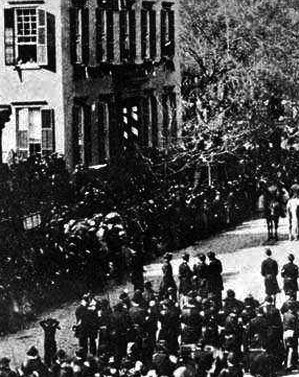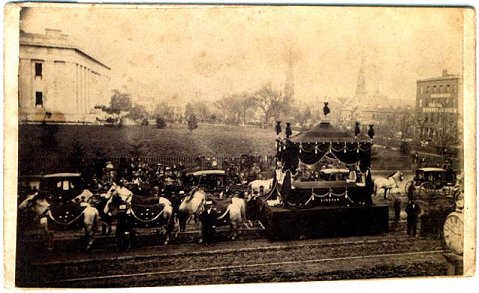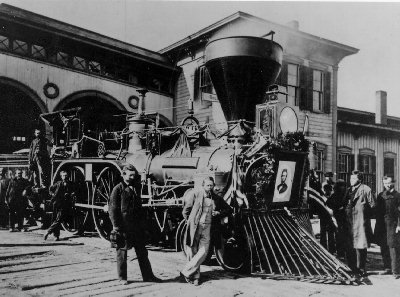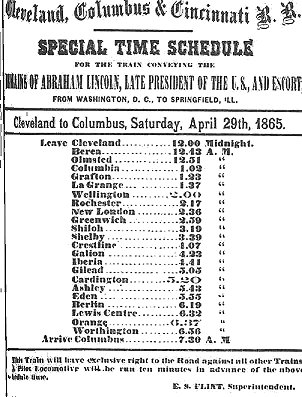THE ROUTE OF ABRAHAM LINCOLN'S FUNERAL TRAIN
|
|
Abraham Lincoln's funeral train left Washington on April 21, 1865. It would essentially retrace the 1,654 mile route Mr. Lincoln had traveled as president-elect in 1861 (with the deletion of Pittsburgh and Cincinnati and the addition of Chicago). An example of a published schedule is pictured to the right. The Lincoln Special, whose engine had Mr. Lincoln's photograph over the cowcatcher, carried approximately 300 mourners. Willie Lincoln's coffin was also on board. Willie, who had died in the White House in 1862 at age 11, had been disinterred and was to be buried with his father in Springfield. A Guard of Honor accompanied Mr. Lincolnís remains on the Lincoln Special. Mr. Robert Lincoln rode on the train to Baltimore but then returned to Washington. The following information summarizes the martyred president's final journey home. |
|
|
|
Friday, April 21
The train of dark-garlanded cars departed Washington's Baltimore and Ohio railroad depot at 8:00 A.M. Stops were made at Annapolis Junction and Relay Station. The train arrived in Baltimore, 38 miles away, at 10:00 A.M. where Mr. Lincoln's coffin was borne to the Merchant's Exchange Building and opened to the view of approximately 10,000 people in three hours. The train departed at 3:00 P.M. from the Howard Street Station destined for Harrisburg, Pennsylvania, arriving there shortly after 8:00 P.M. It was a 58-mile trip. The coffin was then carried by hearse to the state House of Representatives, placed in a catafalque, and opened for public viewing at 9:30 P.M. |
|
Saturday, April 22
At 10:00 A.M. 40,000 people lined Harrisburg's streets to watch the hearse carry the coffin back to the depot. At 11:15 A.M. the train departed Harrisburg for the 106-mile journey over the Pennsylvania Railroad to Philadelphia where it arrived at the Broad Street Station at 4:30 P.M. A hearse took Mr. Lincoln's coffin through Philadelphia's jam-packed streets to Independence Hall. There the coffin was placed in the East Wing where the Declaration of Independence had been signed. Viewing that evening was by invitation only.
 
The Lincoln Special at the Harrisburg station and its arrival in West Philadelphia
|
|
Sunday, April 23
Long lines of the general public began forming by 5:00 A.M. At its greatest, the double line was three miles long and wound from the Delaware to the Schuylkill. Philadelphia officials estimated 300,000 people passed by Mr. Lincoln's open coffin. The wait was up to five hours. So many people wanted to view Mr. Lincoln's body that police had difficulty maintaining order in the lines; some people had their clothing ripped, others fainted, one broke her arm. |
|
Monday, April 24
The Lincoln Special departed Philadelphia from Kensington Station at 4:00 A.M. headed for New York which was an 86-mile trip. While in New Jersey, the train passed through Trenton, Dean's Pond, Princeton, New Brunswick, Metuchen, Rahway, Elizabeth, and Newark. The train arrived in an immense train station at Jersey City at 10:00 A.M., but the huge clock inside the station had been frozen at 7:20, the approximate time of Mr. Lincoln's death. Mr. Lincoln's coffin was removed from the railroad car and taken across the Hudson River by ferry. It was then borne to City Hall where it was carried up the circular staircase under the rotunda. The coffin was then placed in a black velvet dais. The public was admitted after 1:00 P.M. At one point more than 500,000 people waited in line to view Mr. Lincoln. On this day a photograph of Mr. Lincoln in death was taken. To view it, CLICK HERE.

Sketch of New Yorkers passing by Mr. Lincoln's coffin
|
|
Tuesday, April 25
At about 2:00 P.M. Mr. Lincoln's coffin was placed on a magnificent 14-foot long funeral car. It was drawn by 16 horses wearing long blankets. A funeral procession began that went up Broadway to Fourteenth Street, over to Fifth Avenue, up Fifth to Thirty-fourth Street, and across Thirty-fourth to Ninth Avenue to the Hudson River Railway Depot. 75,000 ordinary citizens marched in the huge procession through New York's jam-packed streets. Windows along the route rented for up to $100 a person. When the procession neared Union Square, it passed Theodore Roosevelt's grandfather's home where the 6 1/2 year old future president was viewing the proceedings from a second story window. Shortly after 4:00 P.M. the funeral train was on its way again - this time headed for Albany (141 miles away). During this leg of the journey the train was pulled by a locomotive named the Union, and the pilot engine was named the Constitution. Large crowds of spectators gathered as the train passed through Manhattanville, Yonkers, Dobbs Ferry, Irvington, Tarrytown, Sing-Sing, Peekskill, Garrison's Landing (opposite West Point), Cold Spring, Fishkill, New Hamburg, Poughkeepsie, Hyde Park, Staatsburg, Rhinebeck, Barrytown, Tivoli, Germantown, Hudson, Stockport, Coxsackie, Stuyvesant, Schodack, and Castleton. The train arrived in Rensselaer at 10:55 P.M., and from there the casket was ferried across the Hudson River to Albany. Throngs of people watched as the coffin was moved to the State House for public viewing. Throughout the night the local citizenry passed by to pay their last respects to the slain president.

Young Teddy Roosevelt (upper left corner) watches the procession
|
|
Wednesday, April 26
At noon at special grand procession got underway in Albany with Mr. Lincoln's coffin resting in a specially built catafalque. On this day Mr. Lincoln was drawn by six white horses. At 4:00 P.M. in the afternoon the funeral train departed Albany headed for Buffalo and a 298-mile trip via the New York Central Railroad. Great crowds gathered as the Lincoln Special passed through Schenectady, Canajoharie, St. Johnsville, Little Falls, Herkimer, Utica, Rome, Oneida, Syracuse, Rochester, and others. |
|
Thursday, April 27
The train arrived in Buffalo at 7:00 A.M., and the coffin was transported to St. James Hall in a magnificent catafalque drawn by 6 white horses dressed in black. In an orderly manner, 100,000 people passed by the coffin during the day. The mourners included ex-President Millard Fillmore and future President Grover Cleveland. There was no formal funeral procession in Buffalo as that city had staged a complete mock funeral on April 19 not knowing at that time it was to be a stop on the train's itinerary. At 10:00 P.M. the train left Buffalo for Cleveland, a journey of 183 miles.
|
|
Friday, April 28
At 1:00 A.M. the train made a brief stop at Westfield, New York, where five young women brought a cross of flowers to Mr. Lincoln's coffin. At 7:00 A.M. the train arrived at Euclid Street Station in Cleveland. The coffin was transported by hearse to Cleveland's Public Park and placed in a pagoda in Monument Square; only in Cleveland was the public viewing done outdoors. Thus the others cities' problems of cramped quarters and thousands left in line were avoided in Cleveland. In 15 hours, 150,000 were able to pass by the coffin. At midnight the Lincoln Special departed Euclid Street Station in Cleveland destined for Columbus via the Cleveland, Columbus, and Cincinnati Railway (a 135-mile trip). |
|
Saturday, April 29
The train arrived in Columbus at 7:30 A.M. The coffin was carried in a 17-foot long hearse to the State Capitol building. Upon arrival, 8 members of the Veteran Guard carried the coffin into the rotunda on their shoulders. The catafalque in Columbus was different from all the rest on the trip in that it was without columns and canopies; it was just a low moss and flower covered dais. Again, thousands and thousands of people viewed the fallen president. At 8:00 P.M. the train departed Columbus headed for Indianapolis (187 miles away). The train passed through Urbana, Piqua (10,000 people gathered there at midnight) and others.

Mr. Lincoln's funeral procession in Columbus
|
|
Sunday, April 30
In Indiana the train went through Richmond (while the church bells rang tumultuously), Centreville, Germantown, Cambridge, Knightstown, Charlotteville, and others. It arrived in Indianapolis at 7:00 A.M. The coffin was carried to the Indiana State House in a hearse topped by a silver-gilt eagle. Although rain had been almost an everyday occurrence on the journey, it was so heavy in Indianapolis that the giant procession was canceled and the entire day devoted to viewing. Because of the rain, Governor Oliver P. Morton failed to give his oration. Streetcars in Indianapolis bore slogans of mourning: Car #10 said, “Sorrow for the Dead; Justice for the Living; Punishment for Traitors.” Car #13 said, “Fear Not, Abraham; I Am Thy Shield; Thy Reward Shall Be Exceedingly Great.” Car #20 said, “Thou Art Gone and Friend and Foe Alike Appreciate Thee Now.” Late in the evening the Lincoln Special departed Indianapolis destined for Chicago, a journey of 210 miles. |
|
Monday, May 1
During the night the train passed through Whitestown (100 people gathered around a single bonfire at 1:00 A.M.), Lebanon, Thorntown, Colfax, Clarksville, Lafayette, and others. On the way to Chicago the train stopped at Michigan City, Indiana, where an impromptu funeral was held during the morning. The train arrived in Chicago at 11:00 A.M. and did not go the full distance to the Union Depot. It stopped on a trestle that carried the tracks out into Lake Michigan for some distance. Chicago's procession for Mr. Lincoln rivaled New York's in size and grandeur. The route went down Michigan Avenue, then Lake Street, and then Clark to Court House Square. The coffin was opened for public viewing at the Cook County Court House on Clark Street at 6:00 P.M. and lasted through the night and all the next day. |
|
Tuesday, May 2
Throughout the day, at the rate of 7,000 people per hour, mourners passed by Mr. Lincoln's coffin. The body's discoloration, noticeable in New York, had reached the extent of distressing the viewers. At 8:00 P.M. the hearse carried the coffin to the depot of the St. Louis and Alton Railroad. The Lincoln Special was now destined for its final stop: Springfield, 184 miles away. During the trip the train passed through Fort Wayne Junction, Bridgeport, Summit, Joy's, Lemont, Lockport, Joliet (estimates varied but up to 12,000 persons may have been gathered there at midnight), Elwood, Hampton, Wilmington, Stewart's Grove, Braceville, Gardner, Dwight, Odell, Cayuga, Pontiac, Ocoya, Chenoa, Lexington, Towanda, Bloomington, Shirley, Funk's Grove, Mclean, Atlanta, Lawn Dale, Lincoln, Broadwell, Elkhart, Williamsville, Sherman Station, and Sangamon.
The image of the Chicago to Springfield Time Table was graciously contributed to this website by an anonymous donor. Thank you very much!
|
|
|
|
Wednesday, May 3
Mr. Lincoln's hometown was reached the next morning, and the train pulled into the Chicago and Alton depot on Jefferson Street. Mr. Lincoln would lie in state in the State House's Hall of Representatives (the same room in which he gave his famous "House Divided" speech). Mr. Lincoln's face had become further discolored, and Thomas Lynch, an undertaker, using rouge chalk and amber restored the face to near normal color. Shortly after 10:00 A.M. the doors were opened to the long line of mourners. Additionally, hundreds of people gathered around Mr. Lincoln's home where his horse, Old Bob, now 16 years old, and his dog, Fido, had been brought back for the day. |
|
Thursday, May 4
The day of Mr. Lincoln's Springfield funeral was a scorcher. At 10:00 A.M. the doors to the State House were closed, and Mr. Lincoln's body was prepared for burial by the undertaker and embalmer. The coffin was carried to an elegant hearse (finished in gold, silver, and crystal) lent to Springfield by the city of St. Louis. The procession was led by Major-General Joseph Hooker and followed a zigzag route from the State House, past Mr. Lincoln's home, past the Governor's Mansion, and onto the country road leading to Oak Ridge Cemetery. The hearse was followed immediately by Old Bob wearing a mourning blanket. Mr. Lincoln's only two blood relatives in attendance that day were his son, Robert, and his cousin, John Hanks. Mrs. Lincoln was still in mourning in the White House. The procession was the largest spectacle the Midwest had ever seen. Upon arrival at the cemetery, the coffin was laid upon the marble slab inside the tomb. Willie's little coffin was also placed inside the tomb. The funeral oration was given by Bishop Matthew Simpson who had been chosen over every other minister in the United States for this sad occasion. Simpson gave an extremely eloquent address. When Simpson was finished, Dr. Phineas Densmore Gurley read the benediction. The crowd then watched as the gates of iron and the heavy wooden doors of the tomb were closed and locked. It was over at last.

The hearse used for the Springfield procession
|
|
This account of Abraham Lincoln's funeral train mentions the major stops and only some of the cities through which the train passed. Throughout the long journey, entire populations of rural America were waiting alongside the tracks as the nine car funeral train slowly passed by (the funeral car was the 8th car). For example, officials of Richmond, Indiana, estimated its mourners at 15,000 - a number greater than the city's population - at 3:15 A.M. in the morning! Depending on conditions, the train usually traveled between 5 and 20 m.p.h. Everywhere there were arches draped in black stretched over the tracks. The grandest funeral spectacle in the history of the world ended with the closing of the tomb in Springfield. |
|
|
For added information and fascinating photographs see the outstanding book Twenty Days by Dorothy Meserve Kunhardt and Philip B. Kunhardt, Jr. The Farewell To Lincoln by Victor Searcher is also an excellent resource as is Memorial Record of the Nation's Tribute to Abraham Lincoln by B.F. Morris. Author Barry Schwartz in Abraham Lincoln and the Forge of National Memory adds interesting details and explanation of the outpouring of mourning. The pamphlet Mr. Lincoln’s Railroad Car by H. Robert Slusser is an excellent source of information. Another valuable source is the pamphlet entitled The Lincoln Train Is Coming by Wayne and Cay Wesolowski.
A new standard in Lincoln funeral train literature was achieved by author Scott Trostel with the publication of The Lincoln Funeral Train: The Final Journey and National Funeral for Abraham Lincoln in 2002. For more information on Scott's amazing book please CLICK HERE.
Some of the original furnishings from Mr. Lincoln's funeral car are in the Union Pacific Collection at the Western Heritage Museum in Omaha, Nebraska. The source of the picture of the Minnesota Historical Society’s newspaper about the fire is p. 35 of Mr. Lincoln’s Railroad Car by H. Robert Slusser (Alexandria, Virginia, Alexandria Archaeology Publications, 1996). F.B. Snow’s map of the funeral train’s route came from page 276 of Lincoln: A Picture Story of His Life by Stefan Lorant (New York, W.W. Norton & Company, 1969). Pictured at the top of this page is the locomotive Nashville of the Cleveland, Columbus, and Cincinnati Railroad (Library of Congress). The Nashville pulled the funeral train from Cleveland to Columbus (source: The Lincoln Train Is Coming by Wayne and Cay Wesolowski).
The following information comes from an article in the February 1, 1996, edition of the Polish-American Journal: When the military railroad system was disbanded and returned to civilian control, Mr. Lincoln’s extraordinary funeral car was sold for $6,850 to the Union Pacific RR. It was later sold to entrepreneur Franklyn Snow for $2,000. His efforts to use the car as a commercial exhibit in the Midwest met with limited success, so he sold the car to former Soo Line president Thomas Lowry. Lowry restored the Lincoln funeral car and promoted it as the "most sacred relic in the United States." Featured at several exhibitions across the country, the car was destroyed on March 18, 1911, after a fire swept through a portion of a Minnesota community where it was stored.
The prairie fire swept through 10 blocks of Columbia Heights, an Anoka County village which adjoined the northeast city limits of Minneapolis. |
|
 The Car Used for the Funeral at the Alexandria, Virginia, Train Station in January 1865 (Andrew J. Russell / Library of Congress Photo)
The Car Used for the Funeral at the Alexandria, Virginia, Train Station in January 1865 (Andrew J. Russell / Library of Congress Photo) |
 President Lincoln’s Funeral Car (National Park Service Photo)
President Lincoln’s Funeral Car (National Park Service Photo) |
 The Funeral Car in Omaha, Nebraska, in 1898 (Indiana Historical Society Photo)
The Funeral Car in Omaha, Nebraska, in 1898 (Indiana Historical Society Photo) |
 Minnesota Historical Society Photo
Minnesota Historical Society Photo |

Thank you to Richard Lewis whose father,
Carl Lewis, took this picture after the fire in 1911. Richard's photo is not in the public domain.
|
Thank you to David Birnie for originally letting me know the car was no longer in existence.
CLICK HERE to visit Dr. Wayne Wesolowski’s Lincoln Model Funeral Train Exhibit.
|
|















